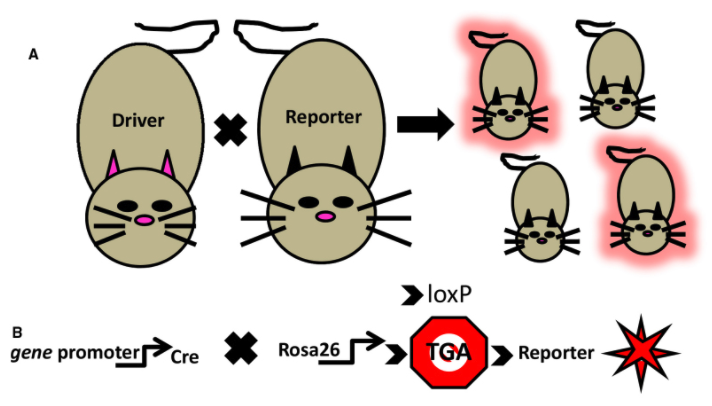这项技术太重要了,做细胞发育的单细胞的不得不用。主要用途就是marking 表达过特定基因的子代细胞,比如Sox10标记的Neural crest,或者做conditional的KO。
同类技术:基因敲除,编辑等。
基本解释:
Cre是一个细菌的蛋白,可以切割带LoxP序列的DNA,LoxP的不同排列也会导致不同的结果。
Animals transgenic使用的小鼠都是转基因的:
- Sox10::CreERT2 (SER93) driver【注意写法,CreER就是融合蛋白】
- Rosa26EYFP or Rosa26Confetti reporters【就是Rosa26这个位点连一个荧光蛋白】
最终缩写 SER93|EYFP or SER93|Confetti,在tamoxifen刺激下就会激活。
什么是driver?什么是reporter?
driver就是指靠特定的promoter激活Cre的个体,reporter就是带有荧光蛋白的个体(正常时被终止密码子抑制表达),杂交后就会重组,形成带荧光的后代。

Genetic identification of cells using cre-lox driver: reporter methods.
(A) Mating a gene promotor containing “driver” mouse directed to express cre in a selective fashion to a cre-dependent “reporter” mouse yields offspring which may inherit the driver-reporter combination (red offspring) of genes. Those offspring which do not inherit the combination will not express the identification marker (non-fluorescent offspring).
(B) A currently used strategy is to cross a cre driver mouse to a mouse expressing a cre-sensitive element at a ubiquitously expressed locus like rosa26. At this locus is a Stop codon (Stop sign with TGA) flanked by loxP sites (indicated by arrows) designed to be excised by cre recombinase activity allowing expression of genetically encoded fluorescent reporters (red star symbol) in the target cell population.
Tamoxifen诱导的Cre/loxP
核心:形成了Cre/ER融合蛋白,在Tamoxifen的刺激下才有活性。
Tamoxifen (TAM)-inducible Cre/loxP is one of the most widely used inducible systems for gene regulation. This is in part due to the fact that it enables gene control both spatially and temporally. The inducible Cre/loxP estrogen receptor (ER) transgenic system is used to study both ubiquitous and tissue-specific gene function through the expression of Cre recombinase fused to the G525R mutant form of the mouse estrogen receptor 1 (Esr1) to create a Cre/ER fusion protein1,2.
Cre/ER recombinases remain unexpressed until activated by the TAM metabolite, which provides external and time-specific control of Cre activity.
Optimization of tamoxifen-induced Cre activity and its effect on immune cell populations
reporter
tdTomato
GFP
YFP
CFP
RFP
Confetti
H2B-mCherry
ROSA26是人和鼠里面的一个位置,可以理解为一个不表达蛋白的gene。
ROSA26 is a locus used for constitutive, ubiquitous gene expression in mice. It was first isolated in 1991 in a gene-trap mutagenesis screen of embryonic stem cells (ESCs). Over 130 knock-in lines have been created based on the ROSA26 locus.
The Rosa26 locus on chromosome 6 is frequently used for the integration of transgene constructs to achieve ubiquitous or conditional gene expression in mice. The Rosa26 transcript is spliced into three exons and ubiquitously expressed in all cell types and developmental stages, but not translated to a protein.
Efficient generation of Rosa26 knock-in mice using CRISPR/Cas9 in C57BL/6 zygotes
The mouse Rosa26 locus is particularly useful for genetic modification as it can be targeted with high efficiency and is expressed in most cell types tested.